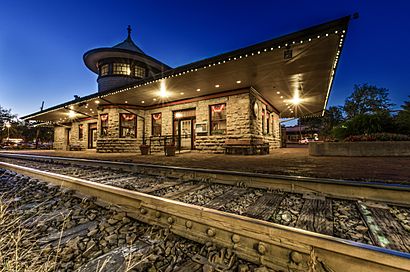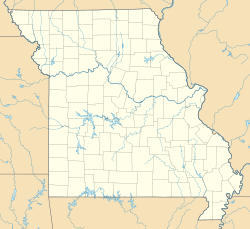Kirkwood station (Missouri) facts for kids
Quick facts for kids
Kirkwood, MO
|
|||||||||||||||||||||
|---|---|---|---|---|---|---|---|---|---|---|---|---|---|---|---|---|---|---|---|---|---|

The Kirkwood Amtrak station in 2012
|
|||||||||||||||||||||
| Location | 110 West Argonne Drive Kirkwood, MO 63122 |
||||||||||||||||||||
| Coordinates | 38°34′51″N 90°24′24″W / 38.5809°N 90.4068°W | ||||||||||||||||||||
| Owned by | City of Kirkwood, Missouri | ||||||||||||||||||||
| Platforms | 1 side platform, 1 island platform | ||||||||||||||||||||
| Tracks | 2 | ||||||||||||||||||||
| Other information | |||||||||||||||||||||
| Station code | KWD | ||||||||||||||||||||
| History | |||||||||||||||||||||
| Opened | 1893 | ||||||||||||||||||||
| Traffic | |||||||||||||||||||||
| Passengers (2018) | 55,213 |
||||||||||||||||||||
| Services | |||||||||||||||||||||
|
|||||||||||||||||||||
| Former services | |||||||||||||||||||||
|
|||||||||||||||||||||
|
Kirkwood Missouri Pacific Depot
|
|||||||||||||||||||||

Kirkwood Amtrak Station as seen from the South Kirkwood Road grade crossing
|
|||||||||||||||||||||
| Location | W. Argonne Dr. at Kirkwood Rd., Kirkwood, Missouri, U.S. | ||||||||||||||||||||
| Area | less than one acre | ||||||||||||||||||||
| Built | 1893 | ||||||||||||||||||||
| Architect | Donovan, Douglas | ||||||||||||||||||||
| Architectural style | Late Victorian | ||||||||||||||||||||
| NRHP reference No. | 85001476 | ||||||||||||||||||||
| Added to NRHP | July 5, 1985 | ||||||||||||||||||||
The Kirkwood train station, also known as the Kirkwood Missouri Pacific Depot, is an Amtrak station in Kirkwood, Missouri. Kirkwood is a town located just outside of St. Louis. This station is in the heart of downtown Kirkwood.
It is one of three Amtrak stations in the greater St. Louis area. The other two are the Gateway Multimodal Transportation Center in downtown St. Louis and the Alton station in Illinois. What's cool about the Kirkwood station is that it's completely run by volunteers! It is also the third-busiest Amtrak station in Missouri.
Contents
A Look Back: The Station's History
Building the Railroad
In 1851, the Pacific Railroad bought the land where the station stands today. This land was needed to build their train tracks. The tracks for the Pacific Railroad reached Kirkwood in 1853.
The very first train arrived on May 11, 1853. It came for an auction where people could buy land lots. This event made Kirkwood the first planned suburb west of the Mississippi River. The town was named after James P. Kirkwood, who was the chief engineer for the railroad.
The Station Through the Years
In 1863, a wooden train building, called a "frame depot," was constructed. Important meetings happened here, like when the first school board met to create the Kirkwood School District in 1865.
Later, in 1893, Douglas Donovan was hired by the Missouri Pacific Railroad. He built the stone station that you see today. This stone building replaced the older wooden one. The current station is a great example of a building style called Richardsonian Romanesque architecture.
Trains that carried people to and from work, called "commuter trains," ran through Kirkwood until 1961. There used to be a special rotating platform, called a "train turn-table," near the current Farmers Market. This was used to turn engines around for their trip back to St. Louis. It also helped "helper engines" get ready to push heavy freight trains up a big hill nearby, known as "Kirkwood Hill." This was before diesel engines were commonly used.
The Kirkwood station is considered a very important historical building. On July 5, 1985, it was officially added to the National Register of Historic Places. This means it's recognized for its special history and architecture.
Fun Times at the Station
Kids growing up in Kirkwood long ago had a lot of fun near the train station. They would often hang out there and even help turn the big engines on the turn-table! Sometimes, they would even catch rides back and forth from the station. This information comes from Nancy Donovan Robinson, whose father was the architect who designed the stone station.



